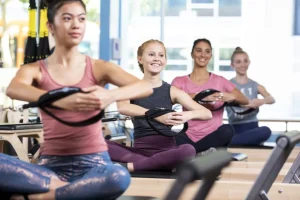Workouts that strengthen and protect the back muscles are crucial for avoiding back pain and staying healthy. Exercise has been shown to limit bone and muscle loss as we age.
To maintain a strong and healthy back, it’s crucial that you include various exercises in your workout. Below are five of the best back exercises to add into your training regime:
1. Bent-Over Row
The bent-over barbell row is an effective compound exercise designed to strengthen multiple upper-body muscles simultaneously, as well as strengthening those that support your spine – aiding posture improvement and potentially decreasing back pain risks.
The barbell row targets all of your main back muscles, specifically lats, rear deltoids and rhomboids. It is an effective way of building strength and size in these muscle groups when used at moderate-to-high resistance levels.
Adjust your grip for optimal results to meet various goals: using a supinated (palms facing up) grip can effectively target biceps; wider overhand grips work the upper back muscles more efficiently; or try a single-arm bent-over row from a split stance position to work your core and enhance stability.
2. Single-Arm Row
One-arm dumbbell rows can be an invaluable addition to your back training regimen, as they not only challenge the upper and lower core in unique ways but also lengthen time spent under tension while targeting muscle groups that might otherwise go underused in traditional rowing exercises.
One common pitfall of this move is over-relying on momentum, and letting your biceps control every rep, which defeats its purpose. To address this, slow down your pace and force the back muscles to do their work instead.
This movement targets your trapezius, rhomboids, and teres major muscles while simultaneously squeezing together your shoulder blades (scapula). This helps avoid rotator cuff injuries as well as promote proper posture.
3. Dead Hang Pull-Up
Are You Seeking Strength or Posture Improvement with Dead Hang Exercise? Regardless, dead hang exercises can be an invaluable addition to your back workout regimen. By lengthening muscles in your back and shoulders, dead hanging helps relieve aches and pains associated with poor posture.
Though performing a dead hang may appear straightforward, even for fit individuals it can be difficult. Yet it remains an essential exercise for mastering full pull ups.
To perform a dead hang, stand behind a bar with your hands slightly wider than shoulder-width apart and grip it tightly with both arms. Use your core and glute muscles to lift your torso into an inverted V position before contracting back and shoulder muscles before slowly lowering yourself down again. Hold this position for 10-60 seconds depending on your strength level and increase as time progresses.
4. Seated Row
Seated rows are an indispensable exercise to build a strong and healthy back. By targeting muscles responsible for shoulder posture and back support, such as the lats, rhomboids, trapezius and posterior deltoids – seated rows help develop an ideal back.
Proper execution of this exercise will ensure you are targeting the appropriate muscles while also avoiding potential injuries. When performing this movement, it’s crucial that you maintain a neutral spine (no curling up of spine) throughout the entire movement.
Start by setting an appropriate weight on the cable machine and taking hold of a handle with an close grip. Sit upright with knees slightly bent while pulling back until the handle touches your stomach – pausing at each rep’s peak before expending on its return – repeat this for all sets.
5. T-Bar Row
Improve your back strength by including rows in your workouts. A stronger back will make deadlifting and squatting more stable while enabling you to bench larger weight.
T-bar rows are an effective compound exercise designed to work multiple muscles at once and can be done at various loads, as long as forward flexion doesn’t put stress on your lower back and spine. However, you must avoid forward flexion as this puts unnecessary strain on both.
The chest-supported T-bar row machine makes this variation easier on your back while enabling you to load more weight, but it may not be available in all gyms. As an alternative method of performing the movement, use a barbell anchored against either a floor or corner wall and grip it pronated, supinated, mixed or hook position when performing machine-less versions of this exercise.





